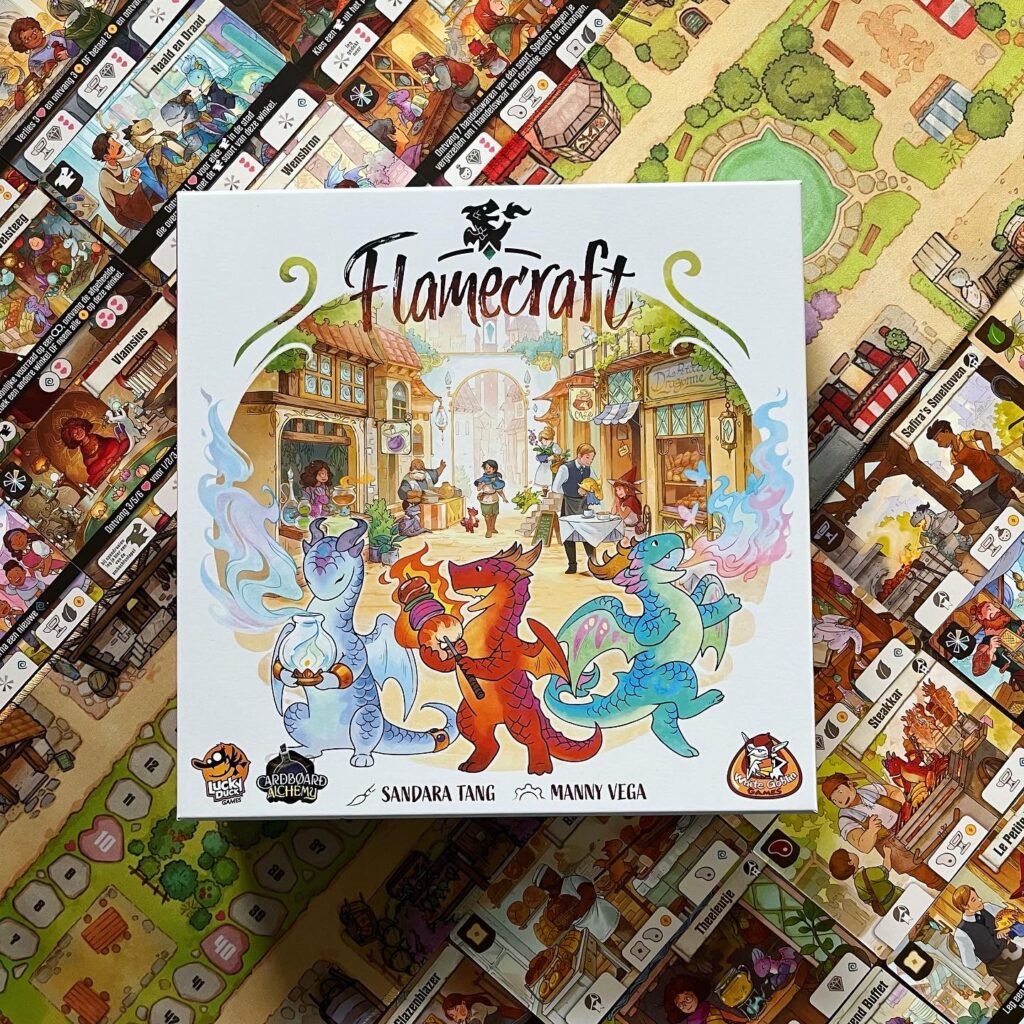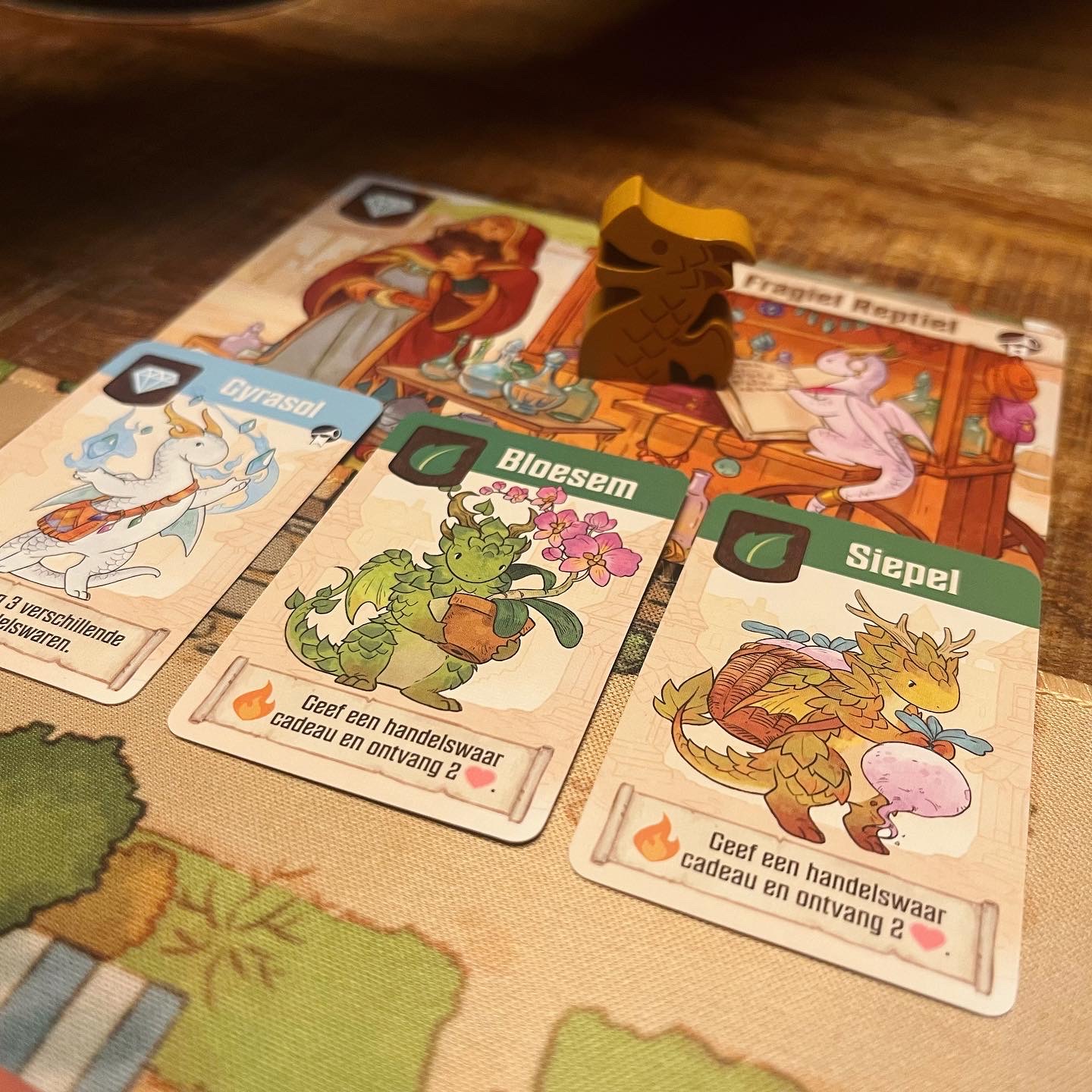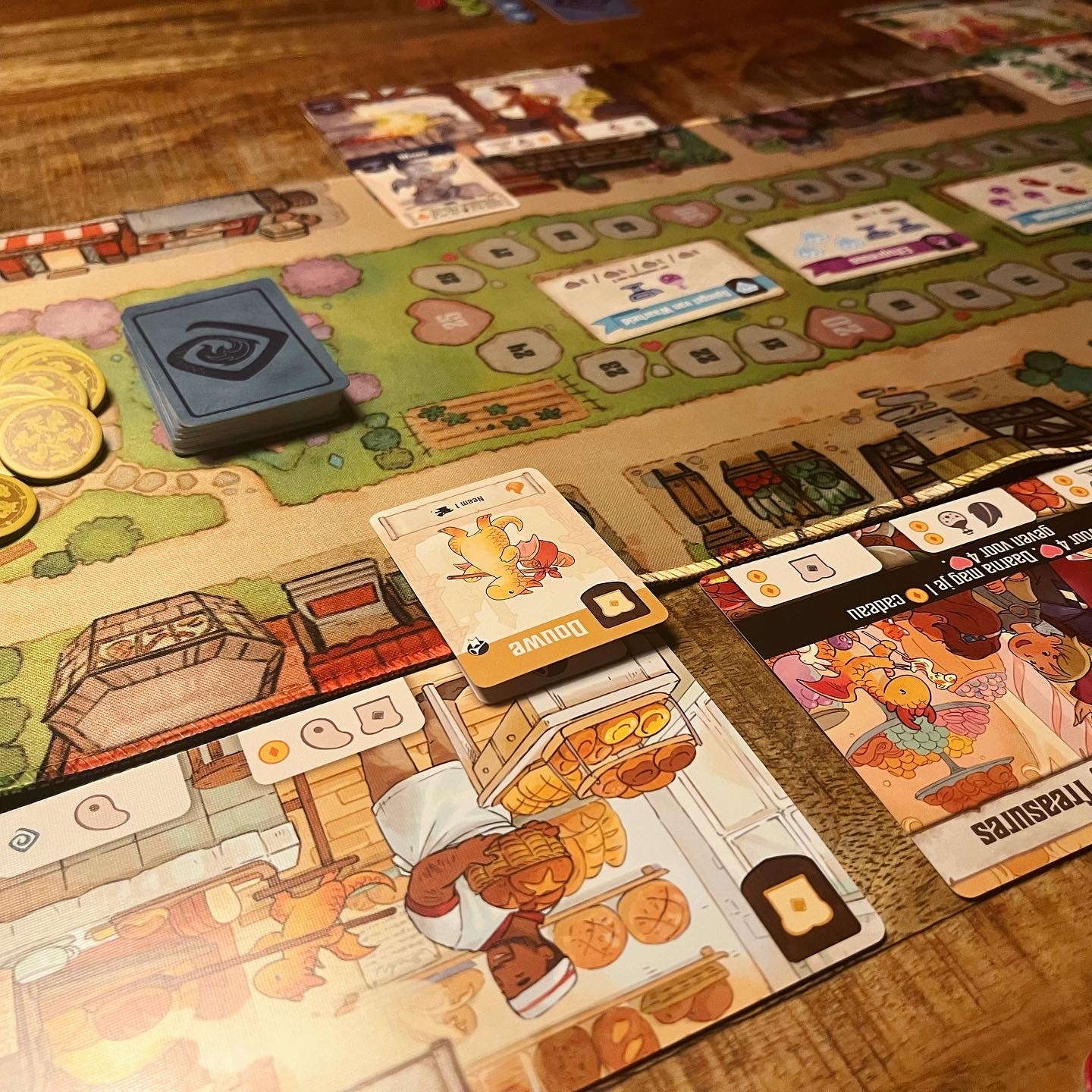In the world of Flamecraft, mankind has learned to team up with friendly dragons to perform all kinds of different crafts. These decent little dragons are the smaller and more magical versions of their classic, larger and dangerous relatives. Instead of destroying castles and cities, these little artisan dragons make beautiful things, including breadful baking, strong smithery and crystal clear crystal works. They delight their customers with their craft dragonry. In Flamecraft, you take on the role of the keeper of flames. These Flamekeepers are highly skilled dragon masters. They can communicate with dragons and train them as a sort of guild master and patron to become crafty craftsdragon. By visiting all the local shops with your dragons, as a sort of secret shopper, and using these dragons for the shopkeepers’ gain, your reputation will grow. If you have built up the most reputation at the end of the game, your eternal flame will be inextinguishable.

Setup
In Flamecraft, 1-5 players take on the role of these so-called Flamekeepers. At the beginning of the game, each player chooses a colour and corresponding dragon figure. On the table, the playing mat (the city) is rolled out. Various cards and other game pieces are placed on and adjacent to the city/playing mat. A stack of dragon cards is placed in the park, from which 5 cards are also turned face up. Some coins are thrown into the fountain for some good luck and prosperity, and next to the fountain a pile of special dragon cards are placed. On the square, 5 enchantment cards are placed and also the corresponding draw pile. Six shops are established around the board with corresponding dragon cards and, finally, next to the board a pile of 10 face-down shop cards are placed. The combination of shop cards that is used is different each game.
Gameplay
In Flamecraft, players try to earn the most reputation by visiting shops, enchanting and adding special dragons to their group of friends. During a game of Flamecraft, players visit a new shop each turn. If another player’s dragon figure is already in the shop, the active player must first give that other player (or players) a ‘gift’ to enter the shop. Once a player has entered the shop, that player chooses one of two possible action phases: collect or enchant.
1. Collect
By collecting, a player goes through several phases in a set order. First, a player collects goods, coins or even dragon cards. The shop, dragon cards and enchantment cards indicate all the items a player can collect during a visit to a specific shop. Next, a player may play a dragon card (craft dragons) from their hand of cards and place it in the shop if the dragon meets the set conditions. Placing a dragon gives a player a one-time bonus. Each shop has space for three dragon cards. By placing dragons, subsequent visits to this shop yield more goods, as well as possibly new actions for all players. This is a bit different from saving stamps or loyalty programs.
Players can choose to activate one of the effects of the active dragons after (possibly) placing a dragon card. Each colour of dragon card has its own effect. By activating the yellow dragons, for example, players can take a new dragon card in hand, and with the red dragon card they can place new dragons in any shop in the city. Because shops sometimes employ different dragons, it is sometimes difficult to make the right decision, as each effect is particularly useful.
Finally, players may be able to activate a shop’s effect. This is not relevant for every shopping spree, but some shops have a special effect. Sometimes players meet special dragons for special bonuses during or at the end of the game.
2. Enchant
By enchanting, players with the right merchandise can ‘buy’ an enchantment card to earn points and bonuses, while also ‘improving’ a shop. Players can only enchant a shop with a corresponding enchantment card. An enchanted shop provides more goods in subsequent visits for all future visitors. And that’s without even having having a loyalty card! After players have enchanted, they may activate all (yes, all!) present dragons.



Verdict
Never judge a book by its cover. At least, that saying usually applies. Flamecraft is beautifully and colourfully designed, the game components are of high quality (especially as far as the deluxe version of the game is concerned) and the ‘look’ is therefore a big draw for many board game fans, who often rely solely on looks anyway. The game’s design reflects exactly what players can expect from the game: a family-friendly game perfectly suited for novice players looking for more of a challenge and experienced players looking for a lighter and more light-hearted gaming experience. The game features beautiful illustrations and components. A bit of nitpicking: my (regular non-deluxe) copy of the game included a playmat where the illustrations had partially ‘fallen’ away at the edges. Probably because too little bleed was used while printing and cutting the playmats. I don’t know if more copies suffered from this. Incidentally, this does not interfere with the enjoyment of the game at all.
The look and theme of Flamecraft also fits well with the snug and cozy nature of the game. Flamecraft contains an extraordinary amount of interaction for a game without any confrontation. Every action of a player affects other players, but actually always in a positive way. Players therefore have to weigh up whether they are influencing other players too much with each choice. After all, every time a player places a dragon or enchantment, subsequent shop visits become more attractive. Also, with certain dragons, players can earn reputation by giving gifts to other players. The only negative interaction/confrontation between players is ‘hijacking’ certain enchantments or getting in the way in certain shops.
The gameplay and structure are easy to explain to new and also younger players but contain enough depth and variety for returning players. Every game there are different shops and also different tactics, strategies and choices. With the shops and spells available, players try to make their day of shopping as efficient as possible. In particular, the road to the most points is a race to buy the most enchantment cards. Players must therefore also smartly draw up and follow their shopping list to buy the enchantments first to earn the most reputation. A blazing day of shopping and with this game the fun is not dragging on but (drag)on!




